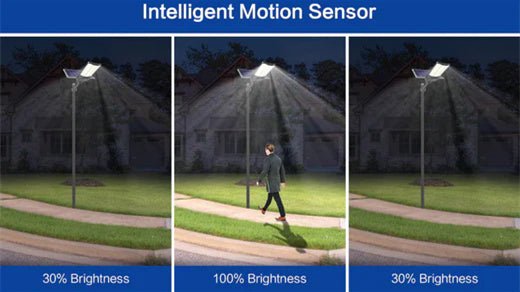1Solar street lights equipped with motion sensors represent a significant advancement in outdoor lighting technology, offering both sustainability and energy efficiency. In this comprehensive blog post, we will explore the mechanisms through which motion sensor solar street lights conserve energy and contribute to environmental sustainability.
Understanding Motion Sensor Technology
Motion sensors, such as Passive Infrared (PIR), Microwave, and Ultrasonic sensors, detect movement within their coverage area. When triggered by motion, these sensors activate the connected lighting system, providing illumination only when needed.
Integration into Solar Street Lights
Motion sensors are seamlessly integrated into solar street lights, typically positioned within the luminaire or in a separate housing adjacent to the fixture. The sensor communicates with the lighting system's controller, which regulates the activation and brightness of the LED lights based on detected motion.

Energy-Saving Mechanisms
- On-Demand Illumination: Motion sensor solar street lights operate on an on-demand basis, activating the lights only when motion is detected. This eliminates the need for continuous illumination throughout the night, significantly reducing energy consumption.
- Adaptive Brightness: In addition to on/off control, motion sensors enable adaptive brightness adjustment based on ambient light conditions and detected motion intensity. This ensures that the lights provide sufficient illumination while minimizing energy usage during periods of low activity.
- Customizable Settings: Solar street light systems offer customizable settings for motion sensor sensitivity, time delays, and brightness levels. Fine-tuning these parameters allows users to optimize energy efficiency according to specific requirements and environmental conditions.

Benefits of Energy Efficiency
- Reduced Energy Costs: By minimizing unnecessary lighting operation, motion sensor solar street lights lower energy consumption and decrease utility expenses, offering long-term cost savings.
- Extended Battery Life: Efficient energy management extends the lifespan of the battery storage system in solar street lights, reducing maintenance frequency and replacement costs.
- Environmental Sustainability: Energy-efficient lighting solutions contribute to environmental sustainability by reducing carbon emissions and minimizing the reliance on non-renewable energy sources.
Optimizing Energy Savings
- Strategic Placement: Proper positioning of motion sensors ensures optimal coverage and reliable motion detection, maximizing energy savings without compromising lighting performance.
- Regular Maintenance: Periodic inspection and cleaning of motion sensors and light fixtures prevent obstructions and ensure smooth operation, maximizing energy efficiency over time.

Conclusion
Motion sensor solar street lights offer a compelling solution for outdoor lighting, combining the sustainability of solar power with the energy efficiency of motion sensor technology. By activating the lights only when needed and adjusting brightness levels based on ambient conditions, these systems maximize energy savings while providing reliable illumination for streets, pathways, and public spaces. Embracing these innovative lighting solutions is not only economically advantageous but also essential for building a greener and more sustainable future.


































Leave a comment
This site is protected by hCaptcha and the hCaptcha Privacy Policy and Terms of Service apply.